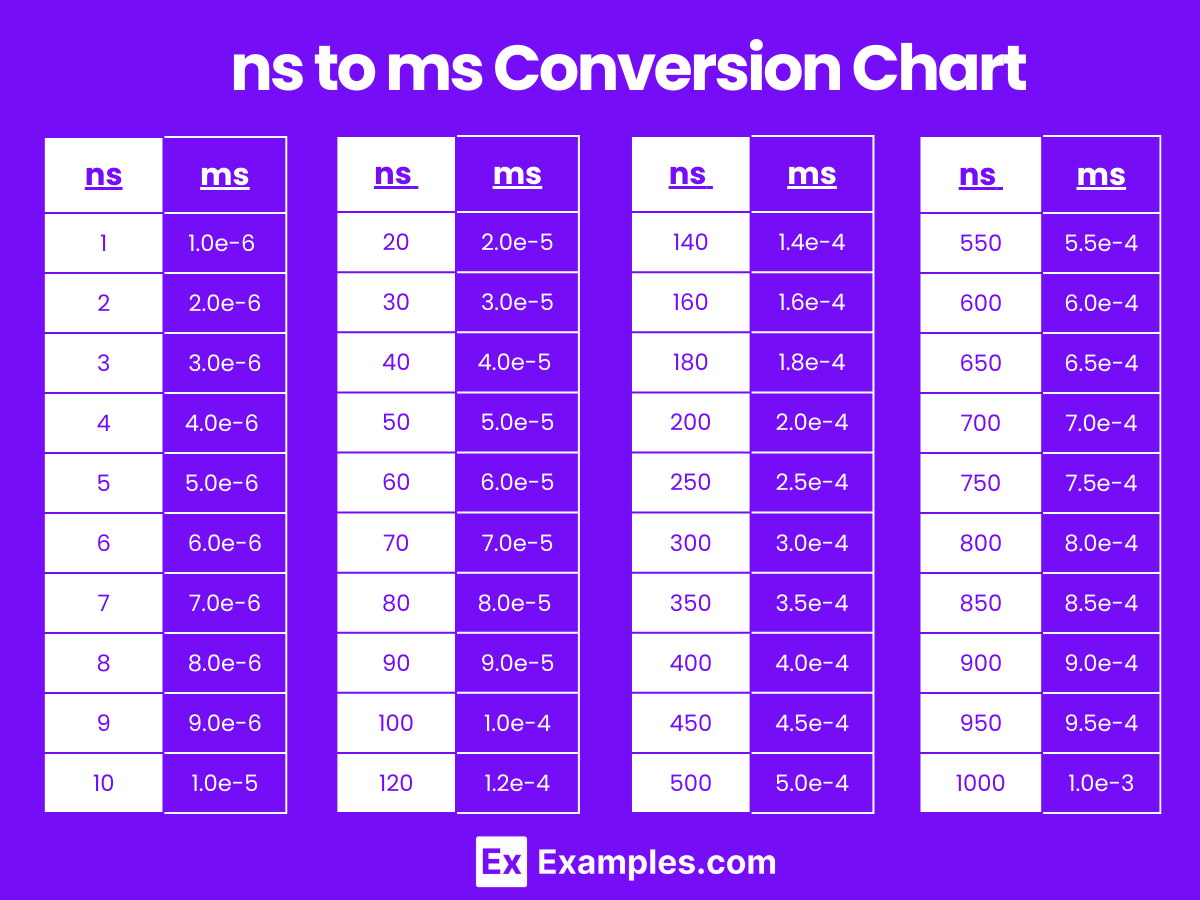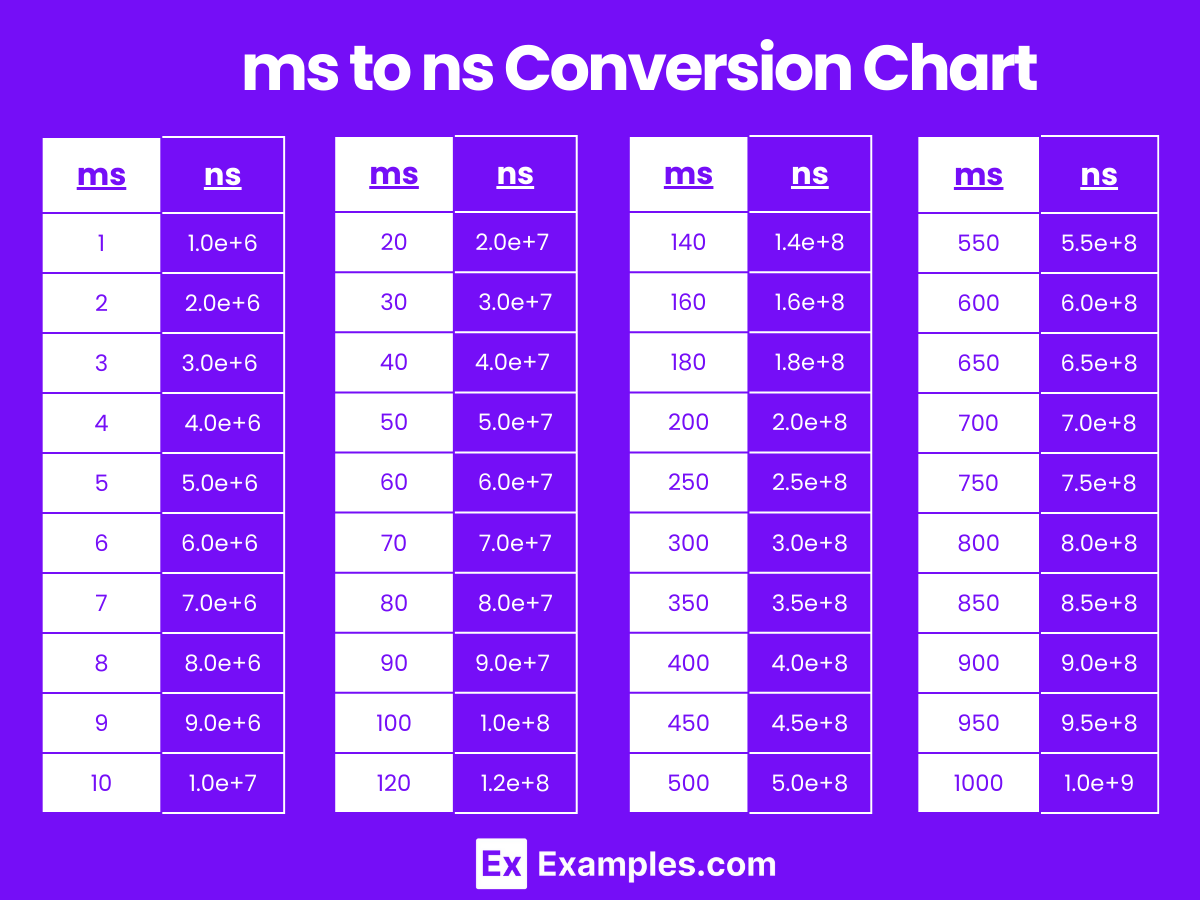Effortlessly convert nanoseconds to milliseconds and vice versa on Examples.com. Enter your measurements for immediate and precise conversions.
ns to ms
Formula: Time in milliseconds (ms) = Time in nanoseconds(ns) ∕ 1000000
Nanosecond :
Millisecond :
| nanoseconds | milliseconds |
|---|---|
| 1 | 0.000001 |
ms to ns
Formula: Time in nanoseconds (ns) = Time in milliseconds (ms) x 1000000
Millisecond :
Nanosecond :
| milliseconds | nanoseconds |
|---|---|
| 1 | 1000000 |
Time Converters to Nanosecond (nm)
Time Converters to Millisecond (mm)
Conversion Factors
- Nanoseconds to Milliseconds: 1 millisecond = 1,000,000 nanoseconds
- Milliseconds to Nanoseconds: 1 nanosecond = 0.000001 milliseconds
How to Convert Nanoseconds to Milliseconds
To convert nanoseconds to milliseconds, divide the number of nanoseconds by 1,000,000.
Milliseconds=Nanoseconds/1,000,000
Example:
Convert 2,000,000 nanoseconds to milliseconds.
Milliseconds=2,000,000/1,000,000=2 milliseconds
How to Convert Milliseconds to Nanoseconds
To convert milliseconds to nanoseconds, multiply the number of milliseconds by 1,000,000.
Nanoseconds=Milliseconds×1,000,000
Example:
Convert 3 milliseconds to nanoseconds.
Nanoseconds=3×1,000,000=3,000,000 nanoseconds
Nanosecond to Millisecond Conversion Table
| Nanoseconds (ns) | Milliseconds (ms) |
|---|---|
| 1 ns | 1.0e-6 ms |
| 2 ns | 2.0e-6 ms |
| 3 ns | 3.0e-6 ms |
| 4 ns | 4.0e-6 ms |
| 5 ns | 5.0e-6 ms |
| 6 ns | 6.0e-6 ms |
| 7 ns | 7.0e-6 ms |
| 8 ns | 8.0e-6 ms |
| 9 ns | 9.0e-6 ms |
| 10 ns | 1.0e-5 ms |
| 20 ns | 2.0e-5 ms |
| 30 ns | 3.0e-5 ms |
| 40 ns | 4.0e-5 ms |
| 50 ns | 5.0e-5 ms |
| 60 ns | 6.0e-5 ms |
| 70 ns | 7.0e-5 ms |
| 80 ns | 8.0e-5 ms |
| 90 ns | 9.0e-5 ms |
| 100 ns | 1.0e-4 ms |
ns to ms Conversion Chart

Milliseconds to Nanoseconds Conversion Table
| Milliseconds (ms) | Nanoseconds (ns) |
|---|---|
| 1 ms | 1.0e+6 ns |
| 2 ms | 2.0e+6 ns |
| 3 ms | 3.0e+6 ns |
| 4 ms | 4.0e+6 ns |
| 5 ms | 5.0e+6 ns |
| 6 ms | 6.0e+6 ns |
| 7 ms | 7.0e+6 ns |
| 8 ms | 8.0e+6 ns |
| 9 ms | 9.0e+6 ns |
| 10 ms | 1.0e+7 ns |
| 20 ms | 2.0e+7 ns |
| 30 ms | 3.0e+7 ns |
| 40 ms | 4.0e+7 ns |
| 50 ms | 5.0e+7 ns |
| 60 ms | 6.0e+7 ns |
| 70 ms | 7.0e+7 ns |
| 80 ms | 8.0e+7 ns |
| 90 ms | 9.0e+7 ns |
| 100 ms | 1.0e+8 ns |
ms to ns Conversion Chart

Difference Between Nanoseconds to Milliseconds
| Aspect | Nanoseconds (ns) | Milliseconds (ms) |
|---|---|---|
| Definition | A nanosecond is one billionth of a second (1 ns = 1 x 10^-9 seconds). | A millisecond is one thousandth of a second (1 ms = 1 x 10^-3 seconds). |
| Usage | Commonly used in computing, telecommunications, and other fields requiring high precision. | Used in everyday timekeeping, electronics, and low-latency computing processes. |
| Precision | Provides extremely high precision, useful for measuring very short time intervals. | Provides less precision compared to nanoseconds but is more practical for many applications. |
| Conversion Factor | 1 nanosecond is equal to 0.000001 milliseconds (1 ns = 1.0e-6 ms). | 1 millisecond is equal to 1,000,000 nanoseconds (1 ms = 1.0e+6 ns). |
| Symbol | Represented by the symbol “ns”. | Represented by the symbol “ms”. |
| Applications | Used in high-speed data transfer, quantum computing, and measuring light travel time. | Used in measuring response times in systems, audio sample rates, and motion capture. |
| Comparison | Much smaller time unit compared to milliseconds. | Larger time unit compared to nanoseconds. |
| Example | The time it takes for a photon to travel one foot is approximately 1 nanosecond. | The time it takes for a standard computer to perform a simple operation is around 1 millisecond. |
1. Solved Examples on Converting Nanoseconds to Milliseconds
Example 1:
Convert 500,000 nanoseconds to milliseconds.
Milliseconds=Nanoseconds/1,000,000
Milliseconds=500,000 ns/1,000,000
Milliseconds=0.5 ms
Example 2:
Convert 2,000,000 nanoseconds to milliseconds.
Milliseconds=Nanoseconds/1,000,000
Milliseconds=2,000,000 ns/1,000,000
Milliseconds=2 ms
Example 3:
Convert 75,000 nanoseconds to milliseconds.
Milliseconds=Nanoseconds/1,000,000
Milliseconds=75,000 ns/1,000,000
Milliseconds=0.075 ms
Example 4:
Convert 1,250,000 nanoseconds to milliseconds.
Milliseconds=Nanoseconds/1,000,000
Milliseconds=1,250,000 ns/1,000,000
Milliseconds=1.25 ms
Example 5:
Convert 9,500,000 nanoseconds to milliseconds.
Milliseconds=Nanoseconds/1,000,000
Milliseconds=9,500,000 ns/1,000,000
Milliseconds=9.5 ms
2. Solved Examples on Converting Milliseconds to Nanoseconds
Example 1:
Convert 3 milliseconds to nanoseconds.
Nanoseconds=Milliseconds×1,000,000
Nanoseconds=3 ms×1,000,000
Nanoseconds=3,000,000 ns
Example 2:
Convert 0.5 milliseconds to nanoseconds.
Nanoseconds=Milliseconds×1,000,000
Nanoseconds=0.5 ms×1,000,000
Nanoseconds=500,000 ns
Example 3:
Convert 12 milliseconds to nanoseconds.
Nanoseconds=Milliseconds×1,000,000
Nanoseconds=12 ms×1,000,000
Nanoseconds=12,000,000 ns
Example 4:
Convert 0.025 milliseconds to nanoseconds.
Nanoseconds=Milliseconds×1,000,000
Nanoseconds=0.025 ms×1,000,000
Nanoseconds=25,000 ns
Example 5:
Convert 8.75 milliseconds to nanoseconds.
Nanoseconds=Milliseconds×1,000,000
Nanoseconds=8.75 ms×1,000,000
Nanoseconds=8,750,000 ns
Why is it important to convert nanoseconds to milliseconds?
Converting nanoseconds to milliseconds is important for applications that require less precision and longer time intervals, such as measuring response times in systems or calculating audio sample rates.
Can nanoseconds be converted to other time units?
Yes, nanoseconds can be converted to other time units such as microseconds, milliseconds, seconds, minutes, etc., using appropriate conversion factors.
What tools can I use to convert nanoseconds to milliseconds?
You can use calculators, online conversion tools, or simple mathematical calculations to convert nanoseconds to milliseconds. Many programming languages also provide built-in functions to handle such conversions.
Is it possible to measure time in nanoseconds accurately?
Yes, with advanced technology like high-resolution clocks and precise measuring instruments, it is possible to measure time in nanoseconds accurately. However, such precision is typically required in specific scientific and technical fields.
How does converting nanoseconds to milliseconds help in scientific research?
Converting nanoseconds to milliseconds helps in scientific research by providing more manageable time units for analysis, especially in fields like physics, chemistry, and biology where precise time measurements are essential.
Are nanoseconds and milliseconds used in everyday technology?
Yes, nanoseconds and milliseconds are used in everyday technology such as computer processors, network latency measurements, and high-speed data transfer.
How does the speed of light relate to nanoseconds and milliseconds?
The speed of light travels approximately 299,792 kilometers per second. In one nanosecond, light travels about 30 centimeters, and in one millisecond, it travels about 300 kilometers.
Can I use spreadsheet software to convert nanoseconds to milliseconds?
Yes, you can use spreadsheet software like Microsoft Excel or Google Sheets. Enter the number of nanoseconds in a cell and use a formula to divide by 1,000,000 to get the milliseconds.
How do digital clocks and timers use nanoseconds and milliseconds?
Digital clocks and timers use nanoseconds and milliseconds for high precision timekeeping, especially in scientific instruments, sports timing systems, and computing devices.
Can I use spreadsheet software to convert nanoseconds to milliseconds?
Yes, you can use spreadsheet software like Microsoft Excel or Google Sheets. Enter the number of nanoseconds in a cell and use a formula to divide by 1,000,000 to get the milliseconds.

